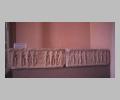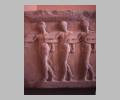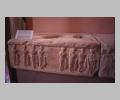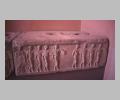
The statue base of Atarbos (<I>IG</I> 2.2, 3025): detail of vi...

Statue base of Atarbos (<I>IG</I> 2.2, 3025): victorious Phyla...

The statue base of Atarbos (<I>IG</I> 2.2, 3025): detail of py...

The left portion of the statue base of Atarbos (<I>IG</I> 2.2,...

The right portion of the statue base of Atarbos (<I>IG</I> 2.2...
| Collection: | Athens, Acropolis Museum |
| Title: | The Atarbos Base |
| Context: | From Athens |
| Findspot: | Found at Acropolis, built into the bastion near the Beulé Gate (1852 |
| Summary: | Pyrrhic dancers, perhaps with Phylai |
| Object Function: | Honorary |
| Material: | Marble |
| Sculpture Type: | Statue base, relief-decorated |
| Category: | Separated fragments |
| Style: | Late Classical/Hellenistic |
| Technique: | Low relief |
| Original or Copy: | Original |
| Date: | ca. 323 BC - ca. 322 BC |
| Dimensions: | D. (relief) 0.015 m |
| Scale: | Miniature (pictorial field) |
| Region: | Attica |
| Period: | Late Classical/Hellenistic |
Subject Description:
Single youth, dancing profile to the right, with his weight on both legs, slightly bent, with his left leg slightly advanced, completely enveloped in a himation, draped over his left shoulder, obscuring his bent, slightly raised, right arm, and his slightly lowered left hand, wearing a taenia in short hair; two groups of three similar figures, the second group adjacent to a nearly frontal female figure (slightly to the right), with her head turned 3/4-view to the left, her weight on her left leg, and her right leg relaxed; she wears a long-sleeved chiton, a himation draped over her left shoulder and around her torso, falling back over her bent left arm, and holds her right hand at her side; a female figure (taller/slimmer than first), standing 3/4-view to the right, with her weight on her left leg, right leg relaxed, wearing a sleeved chiton and a himation draped over left shoulder, wrapped around her body, and falling back over her left arm; eight nude youths, in two groups of four, dancing 3/4-view to the right, each with his weight on his right foot (on tip-toe), with his bent left leg pulled behind it, wearing a small (Attic) helmet, holds his slightly bent right arm, with clenched fist, at his side, and holds sharply foreshortened round shield on outstretched left arm; the shield of each youth except, of course, the first dancer in each group overlaps his predecessor by a different degree.
The pyrrhic dance, one of the earliest contests in the Panathenaia (IG 2.2, 3157) first instituted in Athens as a tribal event at Great Dionysia in 509/508, as the inscription seems to refer to
Form & Style: The relief is framed at the top by a simple taenia (H. 0.033 m) above a bevelled moulding (0.016 m), that bears the inscription, on one line, with the name of Atarbos written in larger letters. At the bottom is a low projecting plinth (H. 0.03 m).
Date Description: Epigraphers prefer to date the base to the time of an earlier Kephisodoros (366), in relation to prosopographical information regarding Atarbos. As Kosmopoulou argues, the style is more akin to the work of the end of the Classical period.
Condition: Intact
Condition Description: Two joining blocks, complete and intact, adhered to a modern plaster base, the left face worked smooth; chipped on all corners and edges; parts of upper moulding broken off, along with inscription; arms and faces of most figures chipped or effaced; background of relief surface worked with tooth and claw chisel; stained grayish-brown, and black in parts, with gray adhesions, and a diagonal crack across the last two figures. Top: surface rough chiselled; join has cuttings for two double-t clamps, chipped around the edges; for statues, on the left block, cuttings for two feet (L. 0.24 m [l.], 0.225 m [r.]; W. [max.] 0.09 m) of a frontal life-size statue, with tooth chisel marks around the cuttings; surface rough picked at bottom of cuttings; on the right block, similar cuttings for two feet (each L. 0.14 m, W. 0.053 m), accentuated by a black painted (?) line, in a square area (W. 0.405 m; L. 0.40 m); to the right, cuttings for two more feet (each L. 0.155 m; W. 0.055 m)
Material Description: White, medium-fine grained marble
Inscription:
Inscription Bibliography: "IG 2.2, 3025"
Sources Used: A. Kosmopoulou, ""The Relief Base of Atarbos, Akropolis Museum 1338,"" in K. Hartswick and M. Sturgeon eds., Studies in Honor of Brunilde Sismondo Ridgway (Philadelphia 1998); Mind and Body, 210 no. 101 (ill.); Die Antike 12 (1936) 84-106, esp. 100-12, figs. 16-17; R. Horn, Stehende Weibliche Gewandstatuen in der Hellenistischen Plastik. RM-EH 2 (1931) 16-17 pl. 4.1; S. Casson, Catalogue of the Acropolis Museum 2. Sculpture and Architectural Fragments 1921, 2.240; W. Klein, Praxiteles (Leipzig 1898)